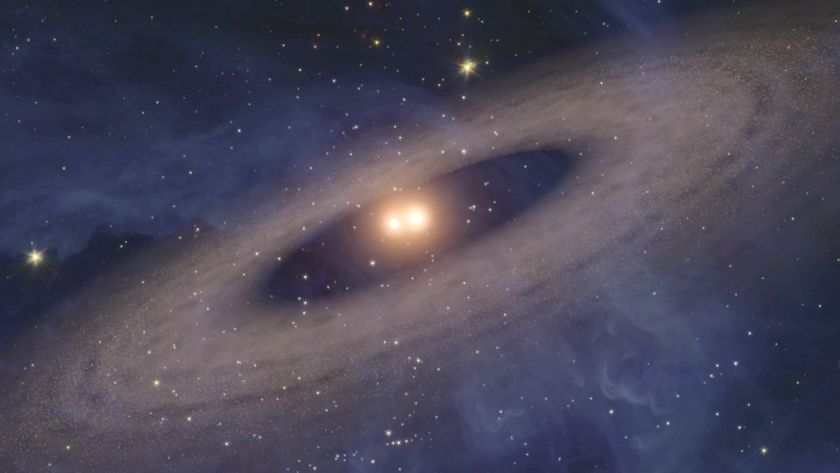Ancient African Skies
"Bwana! That must be it!" I pointed back over my right shoulder at some man-sized stone pillars off on a rise from the dirt road we were driving on. The road would be described by Kenyans as "corrugated" meaning that we had to get out in some places to look for it on our way to the Turkana region--not too far from where the most ancient hominid fossils had been found by Richard Leakey, Director of the National Museums. We had heard of an ancient astronomy site in this region made up of basalt pillars that were magnetic, so needed to be remeasured using something other than compasses. Eddie Frank, of the Tusker Trail Company, some students from various places in the U.S., and I had come to do just that. We had camped with hippos at Lake Nivasha, swum in Lake Turkana known to have over 3 million crocodiles in it, watched as several million pink flamingos had taken to the air around Lake Nakuru, and seen the migration of a couple million wildebeests across the Masaai Mara plains, all on our roundabout safari to this ancient astronomy site.
The pillars were known as "Namoratunga" or "stone people" in the Turkana language. They had been said to have been built for an astronomical purpose, to reckon the Borana calendar, and were reputed to be a couple of thousand years old. They had petroglyphs on them, some matching the ancient property symbols of the Kush, a people of the Sudan who had once conquered Egypt (in the 8th Century B.C.) and whose language has yet to be deciphered. From maps of ancient Kush, I knew that the front of almost all their pyramids appeared to face the star Sirius, which has not changed its position in the sky very much for the last several thousand years.
We had a description of the Borana calendar, but this did not make astronomical sense. For example, the new year of the Borana calendar was said to occur when the star beta Triangulum was "in conjunction" with the new moon (new, give or take a couple of days). A new moon is, of course, close to the sun (i.e., a thin crescent), and consequently found in the twilight sky. However, the star beta Triangulum is a 3rd magnitude star and could not been seen in twilight. Thus, we could not even get the Borana new year started according to the description we had from anthropologists.
We made camp under some acacia trees and the next day tramped over to the ancient site. It was obvious that the stone pillar had been polished by the wind over a long time. We used navigational sextants to measure the angles between each pillar from the others, and a measuring strip to map the interdistances between them. The day was blessedly cloudy--the first such day in the Turkana desert we had seen. We sketched the petroglyphs on each of the pillars as well. And Matunga, our cook, brought us all lunch at the site with some very good Kenyan tea.
Sitting among the pillars it occurred to me that perhaps the translation of the word "conjunction" might have been incorrect. What had been taken to mean "rising with" on the same place on the horizon, might instead mean "rising single-file after." Humm, that could account for having pillars also line up with the stars and the moon. There are seven special Borana calendar stars that define six places in the sky. The Borana calendar stars are: beta Triangulum, Pleiades, Aldebaran, Bellatrix, central Orion and the star Saiph taken together, and Sirius. Well if the single file idea was correct, then at the beginning of the Borana year the star beta Triangulum would rise--mark the place with a pillar, for example--and then at dawn, the new moon would rise in the same location on the horizon. (We were at 3.4 degrees north latitude, so the stars there rise almost vertically--actually 3.4 degrees off the vertical to be exact.) However, this vertical single-file "conjunction" also would not work because (here very close to the equator) the star beta Triangulum was rising about 35 degrees north of east but the farthest north the moon ever got (in its 18.6-year cycle called "regression of the lunar nodes") was 28.5 degrees north of east. So, again, the calendar could not even get started. What kind of a calendar was this, I thought? When we had met with the scientists at the National Museums of Kenya they also did not know how the calendar worked. Yet the Borana are practical people; they would not have made up an apparently ancient calendar that didn't work.
Ah, ancient! I knew that while the star Sirius had not moved much, many of the stars had altered their apparent position on the sky (this "precession" is due to the wobble of the Earth's rotation axis over a complete circle on the sky every 26,000 years). During the time the first pyramids in Egypt were built, the North Star was not Polaris in the Little Dipper, but Thuban, in the constellation of Draco the Dragon. This is where several openings in the great pyramids were aligned. The Namoratunga site was said to possibly be as old as 300 B.C. based on some carbon dating of bones. We precessed the Borana stars then back to 300 B.C., and some "moved" quite a bit. But where was beta Triangulum in 300 B.C.? Before I answer that question, let's take a quick look at how, actually, the Borana calendar is supposed to work.
There are no weeks in the Borana calendar (our 7-day week only comes from the seven ancient planets that appeared to circle the Earth--Sun, Saturn, Moon, then in English a switch to Norse gods--Oden, Thor, and so on). The Borana have 27 day names, and 12 (lunar) month names. The first day of the new year starts on the day name "Bitto Tessa" on the month "Bito Kara." (This is when Triangulum is in "conjunction" with the new moon.) One then simply counts the day names through the month based on that first astronomical observation--conjunction of the new moon at the beta Triangulum position. The description continues; one will know that the next month begins when the new moon is "in conjunction" with the next star or star system, in this case, Pleiades (a blue star cluster). This occurs 29.5 days after the start of the first month. That means that one runs out of day names a couple of days early. This is OK, and the names of the days that started the month are also the names of the days that finish the month. (This is the same for all the months, adjusted for the observations, of course, allowing a variation of a day or two here and there based on the astronomical observation.)
Get the Space.com Newsletter
Breaking space news, the latest updates on rocket launches, skywatching events and more!
The third month starts when one spots the new moon rising "in conjunction with" the star Aldebaran, and so on down the list of six Borana star positions for the first six months. Why does this work? It is because the "sidereal month" (time for the moon to move from a certain star position back to that position again--27.3 days) is not the same as the "synodic month" or the time it takes the moon to go from a particular phase (full-moon to full-moon phase, for example) back to that phase again (29.5 days). The synodic month is longer because the Earth has orbited the Sun just a bit also in a months time and the moon has had to (sort of) "catch up." That is, when the moon arrives at the same place again (star position), the Earth has moved a bit farther and so to align with on the exact opposite side of the Earth from the Sun (same lunar phase again) the moon has to travel a bit farther. (Try this if you like with three people, one the moon, one the Earth, and one the Sun, with the Sun shining a light onto the others they move around the Sun and Earth, respectively; see what happens.)
So, back to the 300 B.C. positions of the stars--would the calendar work if we put the stars back to the same time as the pillars were expected to have been put there? Indeed, the second new moon rose at the exact place where Pleiades used to rise in 300 B.C.! An exciting moment! The next new moon? It rose at the 300 B.C. position of Aldebaran! The next? Bellatrix! The next? In between central Orion and the star Saiph! And finally the 6th new moon of the year rose where the star Sirius rose (and still rises) on the horizon! It worked in 300 B.C.!
Well, it looked as if we had deciphered an ancient calendar! The next six months of the year are defined by a switch of the moving parts. Instead of the horizon location changing, the next six months are defined by the various phases of the moon rising at the Triangulum only position (and therefore one can only check the calendar in the middle of the month). But this all worked too. One goes through the full moon, three-quarter (gibbous) waning moon, quarter waning moon, large crescent waning, medium crescent waning, and finally small crescent waning--all rising at the Triangulum position--until one is back to the new moon at the Triangulum position again and Happy New Year! (The exception is that every three years another month is added because the lunar year is 11 days short of the solar year--this is a kind of "leap month" the Borana folks use.)
So what about the 19 stone pillars that make up Namourantunga--are they indeed used for the ancient Borana calendar? We found that they made 25 alignments with the seven positions on the sky of the ancient Borana stars or star systems. After some calculations, we found that this many alignments could only have occurred randomly about 43 times out of 10,000 random star positions (counting the alignments with the pillars generated randomly by computer, and doing this test of randomly made-up star position 10,000 times for good measure). In other words, we found also that the pillars at Namoratunga--to have made as many as 25 or more alignments with the seven specific ancient positions of the Borana stars-- would only occur randomly 0.43% of the time. From this mathematical experiment we could be about 99.57% sure that the pillars at Namouratuna had been build to do just that--line up with the Borana calendar star positions for 300 B.C.! And the petroglyphs on the pillars? The Turkana said they were ancient family names. This was interesting too, because a lot of them match the symbols on the pyramids of the ancient Kush people--symbols said to be royal property symbols. Perhaps the Kush also got as far south as they did north in ancient times. And perhaps petroglyphs might be a way (besides linguistics and genetics) to trace the migrations of ancient peoples.
As we began the long drive back to Nairobi I felt a quiet excitement. We had discovered a way of keeping time and one of the ways of thinking of some of the ancient African astronomers who had lived in the Turkana desert over two thousand years before. They looked at the sky and understood how it worked and, with the stars and moon as intermediaries, we had shared this special order with them across the millennia. We had read the same book of the sky together, and the practice of timekeeping that so often seems to separate us had, instead, this time brought us closer together.
Note: You can read a more detailed description of the Borana Calendar and Namoratunga at: http://www.tusker.com/Archaeo/articles.htm.
Join our Space Forums to keep talking space on the latest missions, night sky and more! And if you have a news tip, correction or comment, let us know at: community@space.com.
Laurance Doyle is a principal investigator for the Center for the Study of Life in the Universe at the SETI Institute, where he has been since 1987, and is a member of the NASA Kepler Mission Science Team. Doyle’s research has focused on the formation and detection of extrasolar planets. He has also theorized how patterns in animal communication, like those of social cetaceans, relate to humans.












